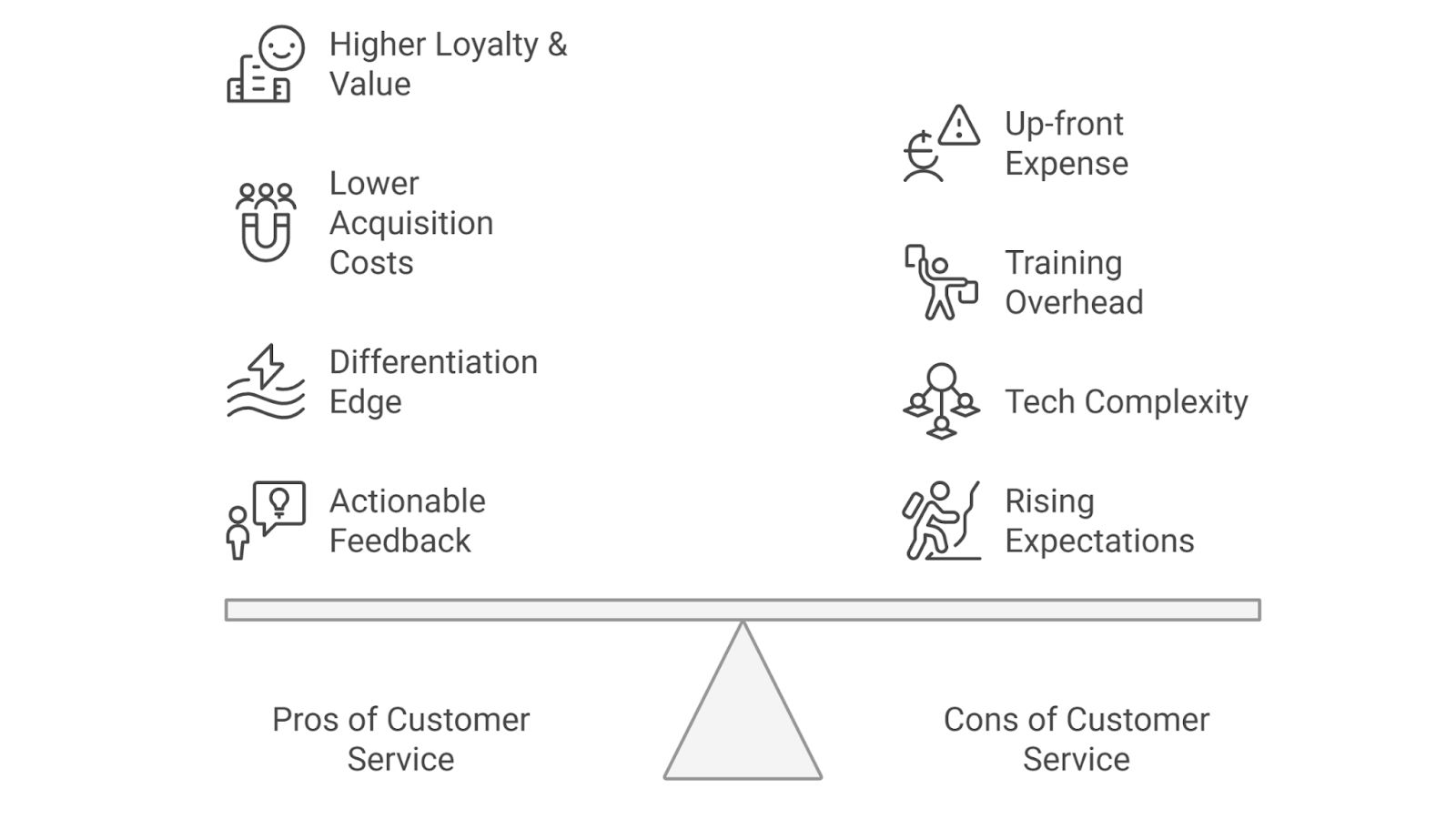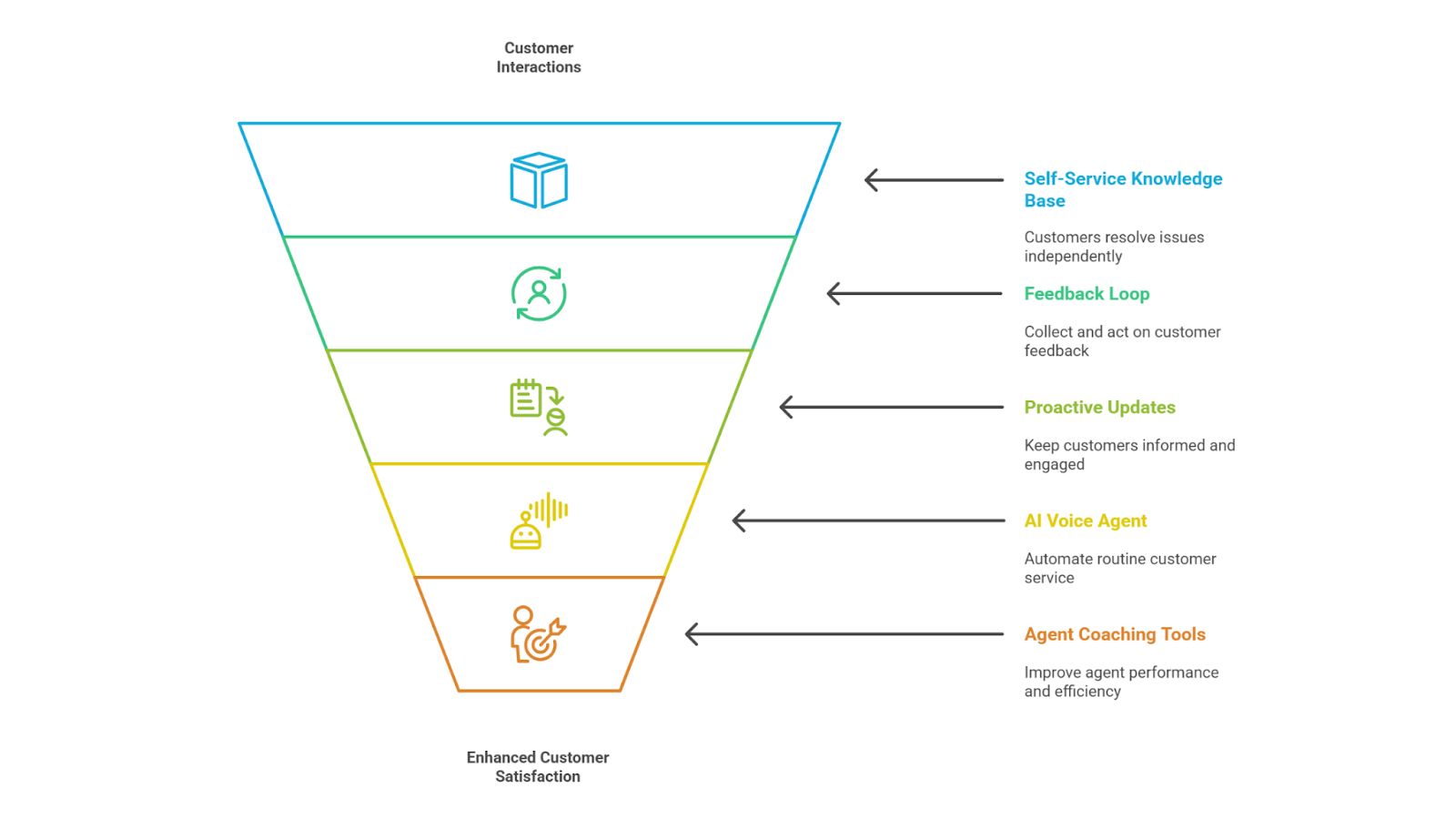You can pour months into designing a brilliant product, yet a single clumsy support call can send a loyal buyer straight to a rival. Recent studies show more than half of customers will leave after just one bad interaction. Flip that around and good service becomes a growth engine: 86 % of shoppers say they’ll gladly pay more for a great experience.
Why Great Customer Service Is Important
Search volume around the phrase why is great customer service important has jumped in the past year, and for good reason:
- Retention beats acquisition. Keeping an existing customer is five times cheaper than winning a new one.
- Word of mouth compounds. Satisfied buyers share on social, leave positive reviews, and casually refer friends free advertising you can’t buy.
- Price becomes secondary. A PwC survey found 73 % of consumers rank experience above price and product features when deciding where to spend.
In short, great service protects revenue you’ve already earned and opens doors to more.
The Human Factor: Why Empathy Is Important in Customer Service
Bots and macros handle routine questions, but empathy seeing an issue through the customer’s eyes is what turns a “transaction” into a relationship. Customers remember how you made them feel long after they forget what was said. Empathetic support:
- Calms tense situations faster, reducing escalations.
- Builds emotional loyalty, which is harder for competitors to steal.
- Surfaces deeper insights (“what they really need”) that can shape product upgrades.
Training reps to pause, acknowledge feelings, and respond in plain language costs little yet pays off in higher CSAT and repeat sales.
Why Product Knowledge Is Important in Customer Service
No amount of empathy saves a call if the agent can’t answer simple questions. Product-savvy reps:
- Resolve issues on first contact, cutting handle time and repeat tickets.
- Spot upsell or cross-sell moments (“You’ll love our newer model that fixes that exact pain”).
- Boost trust. Customers who sense real expertise are more likely to follow advice, purchase add-ons, or forgive small hiccups.
Investing in living product manuals, internal demos, and quick-reference sheets keeps knowledge fresh without expensive classroom sessions.
Why Customer Service Training Is Important
Some founders assume “good service” is common sense. Reality: skills like de-escalation, active listening, and concise writing must be taught, practiced, and refreshed. Structured training:
- Standardizes quality. Every customer hears the same brand voice no matter who answers.
- Shortens ramp-up. New hires hit performance goals faster, lowering wage waste.
- Reduces churn both customer and employee. Confident agents stay longer, and happy agents create happy customers.
Micro-learning modules and peer shadowing sessions keep costs low while knowledge stays current.
Pros and Cons of Investing in Customer Service

| Pros | Why It Pays Off |
|---|---|
| Higher loyalty & lifetime value | Loyal customers spend up to 67 % more over time. |
| Lower acquisition costs | Retention is cheaper than constant new-lead hunting. |
| Differentiation | In crowded markets, service is often the only visible edge. |
| Actionable feedback | Support tickets reveal bugs and new feature ideas. |
| Cons | How to Mitigate |
|---|---|
| Up-front expense | Start small with no-code tools & phased hiring. |
| Training overhead | Use micro-courses and recorded call reviews. |
| Tech complexity | Pick platforms that plug into your CRM out of the box. |
| Rising expectations | Publish clear response-time SLAs to set realistic bars. |
CSAT 101 Your Quick Health Check
Customer Satisfaction Score (CSAT) asks customers to rate an interaction, usually on a 1-to-5 scale. Calculate it like this:
CSAT = (# of 4-&-5 ratings) ÷ (total responses) × 100
2025 Benchmarks
| Industry | Good CSAT Range |
|---|---|
| SaaS | 78–85 % |
| E-commerce | 75–80 % |
| FinTech & Insurance | 72–77 % |
Why CSAT over yearly Net Promoter Scores? Because it gives near real-time feedback that teams can act on this week, not next quarter.
Five Cost-Effective Ways to Boost CSAT

Ordered from the quickest, lowest-lift win to the deeper tech investment.
1. Launch a Self-Service Knowledge Base
Most people prefer fixing easy problems themselves. A clean FAQ, searchable how-to guides, and short explainer videos can deflect up to 40 % of incoming tickets. You can spin up a simple site using markdown files and an open-source search bar in a weekend with no pricey CMS required.
2. Create an Always-On Feedback Loop
Send a one-click survey (email, SMS, or chat) right after each interaction. Tag low scores for same-day callbacks, and share weekly scorecards with the whole team. Cost: pennies per message. Benefit: customers feel heard, and small fixes happen before they snowball.
3. Send Proactive Status Updates
Silence breeds anxiety. Automated order updates, outage notices, or appointment reminders keep customers in the loop and off the phone. Most CRMs offer workflow builders or inexpensive SMS APIs to set up drip alerts in under an hour.
4. Deploy an AI Voice Agent Powered by SuperU
Hold music is a CSAT killer. SuperU’s no-code voice agent answers 24/7 with a 98 % natural tone, handles routine calls (order status, reservations, password resets), and instantly routes complex cases to humans. It scales to a million concurrent calls but starts at roughly $1 K per month, often cheaper than a single full-time agent. Result: slashed wait times, night-and-weekend coverage, and happier customers.
5. Add Real-Time Agent Coaching Tools
Platforms that “listen” to live calls and whisper prompts (“empathize now,” “offer warranty upgrade”) cut average handle time by 15–20 % and boost conversion. Many vendors offer freemium tiers that monitor limited keywords, letting you prove ROI before scaling.
Measuring Success
Don’t fly blind. Track these four numbers weekly:
| Metric | Why It Matters | Starter Goal |
|---|---|---|
| CSAT | Direct feel-good indicator | +5 pts in 90 days |
| FCR (First-Contact Resolution) | Fewer repeat calls | ≥ 70 % |
| AHT (Average Handle Time) | Efficiency with empathy | −10 % |
| Churn Rate | Ultimate loyalty metric | −2 % YoY |
Review in a 15-minute Friday huddle. Celebrate wins, circle back on dips, and tweak workflows fast.
A Five-Step Action Plan
- Audit the journey. Map every touchpoint; note friction.
- Pick one quick win. Usually the knowledge base or feedback loop.
- Pilot for 30 days. Small segment, tight scope.
- Measure rigorously. Did CSAT, FCR, or AHT move?
- Scale or pivot. Double-down on winners; sunset duds.
One change at a time keeps attribution clear and staff stress low.
Conclusion & Next Steps
Customer service isn’t an afterthought it’s a profit center. Great experiences keep wallets open, turn buyers into brand advocates, and protect you in a crisis. Yet you don’t need a blank check to excel. Start with self-service content, gather real-time feedback, communicate before customers have to ask, and layer in smart tech like SuperU’s AI voice agent. Measure relentlessly, train continuously, and let empathy guide the script.
Need a lightning-fast CSAT boost? SuperU’s AI voice agent launches in < 1 hour, handles calls round-the-clock, and cuts support costs up to 40 %. Book your free demo today and hear it in action.
FAQ Section
1. Why is great customer service important?
Great service keeps customers coming back and talking about you. Research shows 83 % of consumers feel more loyal to brands that resolve their issues quickly, and 78 % will buy again even after a mistake if the recovery is handled well. That loyalty jump lifts lifetime value and slashes new-customer acquisition costs.
2. Why is empathy important in customer service?
Empathy turns a routine interaction into a human connection. In one study 96 % of consumers said empathy is critical to support experiences, and brands that train agents to “step into the customer’s shoes” see higher retention and CSAT scores. Empathetic reps defuse tension, uncover real needs, and boost upsells without feeling pushy.
3. Why is product knowledge important in customer service?
When reps know the product inside-out, answers are faster, more accurate, and more persuasive. Deep knowledge cuts resolution time, reduces escalations, and opens upsell or cross-sell opportunities because agents can recommend the perfect add-on in the moment. Customers feel confident they’re in good hands, which drives satisfaction and trust.
4. Why is customer service training important?
Training arms agents with the skills and tools to deliver consistently great experiences. Companies that invest in structured coaching report 5 %+ jumps in CSAT and shorter onboarding cycles, while agents themselves show higher job satisfaction and lower turnover. In short, well-trained teams resolve issues faster, keep customers happier, and protect your bottom line.
Start for Free – Create Your First Voice Agent in Minutes


